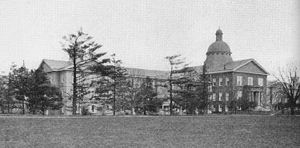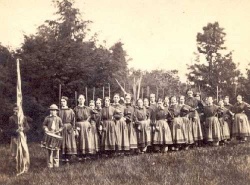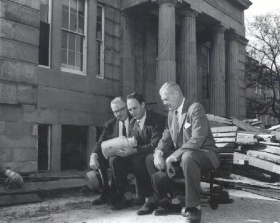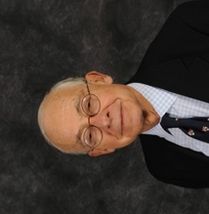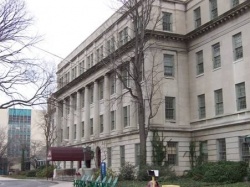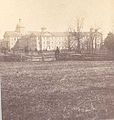Institute of the Pennsylvania Hospital
| Institute of the Pennsylvania Hospital | |
|---|---|
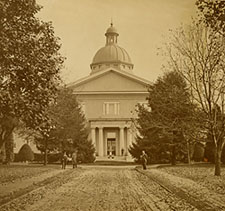 | |
| Established | 1835 |
| Construction Began | Female Dept: 1836 / Male Dept: 1856 |
| Opened | January 1, 1841 |
| Closed | 1997 |
| Current Status | Active and Preserved |
| Building Style | Pre-1854 Plans (Female bldg), Kirkbride Plan (Male Bldg) |
| Architect(s) | Isaac Holden (female bldg) and Samuel Sloan (male bldg |
| Location | Market St, Philadelphia, PA |
| Architecture Style | Late Georgian |
| Alternate Names | *Pennsylvania Hospital for the Insane
|
The Institute of the Pennsylvania Hospital, formally Pennsylvania Hospital for the Insane, was a private psychiatric hospital operating in West Philadelphia from 1841 until its closure in 1997. The building is currently being lease to Blackwell Human Services and the Kirkbride Center, and remains functional within the human services field; however, it is still owned by the University of Pennsylvania Health System. It was greatly expanded in the 1950's to accommodate a larger inpatient population. However, because of changing perception of psychiatry and insurance protocol the facility was forced to close its doors. In 2004, the NHPRC was issued a grant to organize, preserve and make publicly accessible the Institute of the Pennsylvania Hospital's archival collection.
There is a tremendous amount of confusion about the Pennsylvania Hospital in Philadelphia, PA. This is because there were in fact two separate facilities bearing the name. The first, founded in 1751 by Dr. Thomas Bond and Benjamin Franklin was located on Eighth and Pine Streets, and was completed in 1755. This facility is still operational, albeit not for its original purpose. It now largely is maintained because of its historic value to the city and state. This original facility found itself overwhelmed by the number of 'lunatic' patients, and regularly had their insane wards overcapacity. The board of director voted to build a second hospital, in what was then rural West Philadelphia, as was the style of such institutions at the time. This second hospital was known as the Institute of the Pennsylvania Hospital, as to draw distinction from their primary facility. This was also the hospital that Dr. Thomas Story Kirkbride was Superintendent, who is regarded as the father of American Psychiatry.
Contents
History
Under Dr. Kirkbride: 1840-1883
In 1832 the Board of Managers of the Pennsylvania Hospital recognized the necessity of opening a separate asylum with the sole purpose of caring for the insane. A resolution was passed shortly thereafter, as the mentally ill had at that time outnumbered the sick and injured patients. The Pennsylvania Hospital purchased a 101-acre farm in West Philadelphia in 1835 from Matthew Arrison a local merchant. The cornerstone for this new facility was laid on July 26, 1836 on the corner of 44th and Market Streets. The question of selecting an appropriate superintendent was complicated because of the absence of other large psychiatric facilities in the America at the time. Locally, only Friends Hospital, then known at the Frankford Asylum, was operational and was only financially viable because of donations from the Society of Friends. The Board of Manager voted on October 12, 1840 and elected to hire the thirty-one year old alienist, Dr. Thomas Story Kirkbride, as the head of the new hospital. Dr. Kirkbride was born in Morrisville, where his family resided, and graduated from the University of Pennsylvania Medical School only two years prior. He was at the time finishing his residency at the Frankford Asylum before his selection.
Thomas Story Kirkbride gained national renown because of his particular methods. He developed a more humane way of treatment for the mentally ill that became widely influential within American Psychiatry. Today, the former Institute campus exists as a multi-purpose social-service facility. The new hospital, located on a 101-acre (0.41 km²) tract of the as yet unincorporated district of West Philadelphia, offered comforts and a “humane treatment” philosophy that set a standard for its day. Unlike other asylums where patients were often kept chained in crowded, unsanitary wards with little if any treatment, patients at Pennsylvania Hospital resided in private rooms, received medical treatment, worked outdoors and enjoyed recreational activities including lectures and a use of the hospital library. The campus originally featured one, but later, two hospital buildings, which were separated by a creek and pleasure grounds.
The first building was a long thin building located west of the Schuylkill River. This building would eventually become the female department. Though the building does reflect the Kirkbride Plan it was actually constructed before Dr. Kirkbride was given full supervisory duties. Construction began under the control of architect Isaac Holden but later illness forced Issac to return to his home country of England. The building was then finished by a young Samuel Sloan, who worked as a carpenter on the Eastern State Penitentiary. Sloan finished the building in 1841. The building was a rather simple design compared to later Kirkbride Plan buildings. Constructed of stucco covered brick, it was three stories tall with a central administration section flanked on either side by a set of wings. The top of the administration section was crowned with a large dome. On both the front and back of the administration section were stone porticoes. The interior of the building was well furnished, the lavishly carpeted corridors were twelve feet wide. The building features iron stairs, well lighted wards, and iron water tanks in the dome over the administration section, which provided fresh water to all of the building. At the rear corners of either side of the building were smaller, one story, "U" shaped buildings. These buildings were used to house the most noisy and violent patents, so that they wouldn't disturb the calmer, more manageable patients in the main building.
Superintendent Kirkbride developed his treatment philosophy based on research he conducted at other progressive asylums of the day including the asylum at Worcester, Massachusetts. Out of his philosophy emerged what would become known as the Kirkbride Plan, which created a model design for psychiatric hospital that was employed across the United States throughout the 19th century. This plan would be used for the hospital’s second building. On July 7, 1856, the cornerstone for a new building, built with the money from individual contributions, was laid at 49th and Market Streets, five blocks west of the original building. The new structure, which was to house only male patients, was dubbed the Department for Males, while the original building officially became known as the Department for Females. Dr Kirkbride commissioned Architect Samuel Sloan to design the new building. Built of stone and brick, the new building was laid out, as Kirkbride expressed, "in echelons." A large rectangular building, 3 1/2 stories tall, with gable roof and central dome, and a 2 story pedimented portico on its western facade, provided the central focus of the hospital and also housed its administrative offices. Extending from the center of this building to the north and south are two symmetrical wings about 250 feet long, 3 stories tall with gable roofs and ventilation cupolas at their furthermost termini. These wings were in turn connected to another pair, which extended to the east approximately 230 feet, paralleling each other, and of the same general appearance. At each terminus of the these rear wings was a final E-shaped wing which extended out approximately 250 feet. The north E wing housed troublesome patients, and the south E wing has since been removed. No wings are exactly in line, thus allowing fresh air to reach each wing on all four sides. Each of the patients' rooms in the wings had its own fresh air duct, the air being driven in from the towers at the terminus of each wing. There were 16 wards in the hospital, one for each of 16 distinct classes of patients, and each ward had its own parlor, dining room, and bathroom. Outside, there were gardens, shops, and walks for the patients.
For the first seventy years of its existence Pennsylvania Hospital for the Insane steadily increased in its size and clinical complexity. As early as February 1844 the trend for expansion had been firmly established. The Public Ledger took note of the statistics in Kirkbride’s annual report and published the following brief article: We have received a copy of the Report of the Managers of the Pennsylvania Hospital for the Insane for 1843. There were 140 patients admitted during the year, 126 have been discharged or died, and there remain 132 under care. There were cured 68, much improved 7, improved 14, stationary 20, died 17 – total 126. The Report contains a number of statistical tables, showing the number and sex of the persons admitted since the opening: their ages, occupations, condition, nativity, country, and the causes which produced insanity in them, with the duration and number of the attacks. Since the opening of this Hospital, three years since, there has been a steady increase in the number of patients admitted, and the number under care at one time has constantly been augmenting. The total number under care in 1841, was 176; in 1842, 238; in 1843, 258.
Expansion of the site continued, and by 1851, just ten years after its opening, the Hospital was "inconveniently crowded", though the [Annual] hospital report stated that "the general good health which then prevailed, enabled us to receive all the cases that were brought to the Hospital, although much difficulty was often experienced in accommodating them." Two years later, the annual report for 1853 became more grim, and stated: during the entire year, the institution has been rather more than comfortably filled, the average number for the whole period, as shown above, being 229, while 220 is regarded as the capacity of the building. Anxious to receive all who desired admission, we have at no previous time refused any suitable applicant; but during a part of the year just closed, we were for a time compelled, although with great reluctance, to decline receiving patients, except under the most urgent circumstances.
Turn of the Century: 1883 to 1911
The Pennsylvania Hospital for the Insane flourished under Kirkbride until his death on December 16, 1883, though for decades after his death, Philadelphia natives colloquially referred to the hospital as "Kirkbride's." Dr. John Chapin, the former Superintendent of the Willard State Hospital in New York, assumed the role of Superintendent of the Pennsylvania Hospital for the Insane after Kirkbride's demise, following a lengthy election by the Board of Managers. The Board had spent ten months making their selection, which was precarious because of the fame and reputation of Kirkbride. Chapin officially assumed this role on September 1, 1884, and held that office until the resignation from his duties in 1911. He was directly succeeded by Dr. Owen Copp, who initiated a School of Nursing for Men at the Hospital. Dr. Chapin appoints Leroy Craig as the first director of 'the Pennsylvania Hospital School of Nursing for Men'. Craig gains notoriety as the first male superintendent of a male nursing school in the country. Similar schools had previously been established locally at Friends Hospital and Norristown State Hospital. The new school of nursing was devoted to training male nurses in generalized nursing practices, as well as the specialization in the disciplines of psychiatric care.
It is during the second part of the hospital's history that the particulars of its operations change dramatically. Starting in 1876 the number of patients admitted to the inpatient began to drop, which was credited to rise of the Commonwealth of Pennsylvania's involvement in psychiatry as a matter of the public health. This rise in psychiatric care was found to be startling in the Commonwealth of Pennsylvania. When Kirkbride opened the new asylum in 1840 there were a total of 275 beds available for those who suffered from mental illnesses. shared by the facility and Friends Hospital. By 1895, 7,000 inpatient beds had been created between various: private and state hospitals, as well as local sanitariums. While this trend would continue well into the 20th century, Pennsylvania Hospital's inpatient population maximum would not change from the five-hundred beds it was allotted following its expansion in 1853. While the Institute would remain an industry leader, it was longer the only psychiatric facility available to the public regionally.
Medical Staff Directory: 1840-1915
The original organization of Alienist physicians within Pennsylvania Hospital was severely limited. Dr. Kirkbride had laid the foundation of this level of medical hierarchy, which would be maintained to some degree until 1915. This hierarchy places the superintendent as charge and master of all medico-psychiatric issues taking place within the hospital, and an assistant physician to aid to either the male or female departments. Since this was a considerable prestigious post for many psychiatrists it became a starting point for many early careers within the field. However, shifting conceptions of psychiatric care changed in the early 20th century, largely due to legislation lobbied for by Pennsylvania's Committee on Lunacy. Additionally, the 'Food and Drug Act' of 1914 drastically altered the landscape of psychotropics within American Psychiatry. As a result, the Board of Managers of Pennsylvania Hospital, under the guidance of Dr. Owen Copp, reorganized the structure of inpatient treatment and effectively tripled the number of physicians employed to treat the insane. Attending Physicians were also allotted significantly smaller caseloads of patients, from rough 250 per doctor in 1880, to 62 in 1915. This measure also stood in stark contrast to the public mental health facilities of the period, which were notorious for being chronically understaffed.
- 1) Thomas Story Kirkbride - Hospital Superintendent, 1840-1883
- 2) Edward Hartshorne - Assistant Physician, 1841-1894
- 3) Francis Smith - Assistant Physician, 1841
- 4) Robert A. Given - Assistant Physician, 1842-1844; Later the Founder of Burn-Brae Hospital in Clifton Heights, PA.
- 5) John Curwen - Assistant Physician, 1844-1849; left to become Superintendent of Harrisburg State Hospital in 1850.
- 6) Thomas J. Mendenhall - Assistant Physician, 1849- 1851
- 7) J. Edwards Lee - Assistant Physician, 1851-1856, 1862-1868
- 8) Edward A. Smith - Assistant Physician, 1856-1862
- 9) Preston Jones - Assistant Physician, 1859-1884
- 10} William Longshore - Assistant Physician, 1860-1862
- 11) James Hall - Assistant Physician, 1863
- 12) Daniel Beitler - Assistant Physician, 1863-1867
- 13) John T. Wilson - Assistant Physician, 1867-1868
- 14) William P. Moon - Assistant Physician, 1868-1883
- 15) J. Roe Bradner - Assistant Physician, 1869-1871
- 16) William H. Bartles - Assistant Physician, 1871-1884, left to establish a private practice in Flemington, NJ from 1884 to 1906.
- 17) Robert J. Hess - Assistant Physician, 1875-1879
- 18) Frank Carson - Assistant Physician, 1879-1881
- 19) Henry Nunemaker - Assistant Physician, 1881-1931
- 20) Henry M. Wetherill - Assistant Physician, 1881-1889
- 21) Charles Franklin - Assistant Physician, 1884-1887
- 22) John Chapin - Hospital Superintendent, 1884-1911
- 23) Edward Brush - Assistant Physician, 1884-1891, left to become Psychiatrist-in-chief of Shepherd-Pratt Hospital from 1891 to 1920.
- 24) William H. Harrison - Assistant Physician, 1887-1894
- 25) Eli E. Josselyn - Assistant Physician, 1887, 1889-1903
- 26) Albert Moulton - Assistant Physician, 1891-1914
- 27) Horace Philips - Assistant Physician, 1894-?, Later sat on the Pennsylvania State Committee on Lunacy.
- 28) Charles B. Williams - Assistant Physician, 1903-1911
- 29) G.W. McCafferty Jr. - Assistant Physician, 1908-1912
- 30) Herbert H. Thompson - Assistant Physician, 1911-1912
- 31) Owen Copp - Psychiatrist-in-Chief, 1911-1922
- 32) Maude M. Rees - Assistant Physician, 1912-1914
- 33) Frederick C. Rinker - Assistant Physician, 1912-1913
- 34) Hendrick A. Ross - Assistant Physician, 1912-1913
- 35) Robert L. Allen - Assistant Physician, 1914-?
- 36) Charles H. Sprague - Assistant Physician, 1914
- 37) Samuel T. Orton - Clinical Director and Pathologist, 1915-?
- 38) Daniel H. Fuller - Assistant Physician, Department for Men, 1915-?
- 39) Horace J. Williams - Assistant Physician, Department for Men, 1915-?
- 40) George T. Faris - Assistant Physician, Department for Men, 1915-?
- 41) Earl Bond - Assistant Physician, Department for Women, 1915-?; Psychiatrist-in-Chief, 1922-1935;
- 42) Alice H. Cook - Assistant Physician, Department for Men, 1915-?
- 43) Uriah F. McCurdy - Assistant Physician, Department for Men, 1915-?
- 44) Edward Strecker - Assistant Physician, Department for Men, 1915-?
Innovation and Expansion: 1912 to 1958
With the dawn of the 20th Century, a particular fascination with professional laboratory science was ushered in. It was posited that by more closely examining the brain and its inner workings, physicians could be able to determine the mysteries of mental illness. Neurologists and Micro-biologists concluded that insanity was a 'disease' of the nervous system, and it should be treated directed. Researchers collected brain specimens of deceased insane patients to search for clues about the nature of such pathologies. These early neuro-psychiatrists were no longer convinced that 'humane treatment' alone was sufficient to bring about psychiatric recovery for most of the clinical population. They looked for more allegedly scientific methods in conducting their various therapies. Reflecting this changing view, the Institute's name was changed in 1918 from 'the Pennsylvania Hospital for the Insane' to the "Department for Mental and Nervous Diseases at Pennsylvania Hospital". This name remained with the hospital for the next four decades. It was also during this period that professional nurses and personnel trained in psychiatry replaced the former attendants.
In 1913, Dr. Edward Strecker joined the hospital as an assistant physician. Over his forty-six years of tenure at the hospital, he became a preeminent author and teacher of clinical psychiatry. In 1920, Dr. Strecker established one of the first psychiatric outpatient community clinics in the world at Pennsylvania Hospital's 8th and Spruce Street campus. This facility, which would later become Hall-Mercer Community Mental Health Center, continues to operate as a well regarding outpatient provider in the City of Philadelphia. Additionally, as a pioneer in the treatment of alcoholism, Dr. Strecker was one of the first physician to presume that alcoholism should be treated as a disease of the mind, not an ethical failing on the part of the individual. In 1935, Pennsylvania Hospital was the first psychiatric institution to hire a recovering person as an addiction counselor, a practice that has since become commonplace. Dr. Strecker, and his former alcoholic patient, Francis Chambers, Jr., developed the "dual diagnosis therapy" approach for recovery alcoholics, combining abstinence and ongoing psychological counseling. Following his death, the Institute's substance abuse unit was renamed "The Strecker Program" in his honor; and in 1989, it was named "Treatment Center of the Year" by the American Council on Alcoholism.
During the early 20th century, The Institute also introduced outpatient treatment for those with, what was then known as Psycho-Neurosis, -- everyday family and work-related problems, such as: anxiety, sleeplessness, depression or low self-esteem. Psychotic patients in the Institute were transferred to the 44th Street location to make way for outpatient services geared to the community at large. The Institute thus became one of the few hospital programs nationally to treat patients ranging from the severely mentally-ill, to those needing help with the stresses of their everyday living. This is commonly regarding as the beginning of the de-institutionalization movement, which in tragic irony, would ultimately have the Institute itself shut down.
Once surrounded by 130-acres of grounds, the hospital by the 1930's was now contained in approximately 27-acres bounded on the North and South by Haverford Avenue and Market Street, and on the East and West by 48th and 49th Streets respectively. The hospital continued to expand, and had many new buildings added during this period. Two additions were made to the Kirkbride original structure. The auditorium on the northern side of the north wing, which runs east to west (which still stands. Additionally, a wing was extended back from the primary entrance building and connects with the northern extension off the original central building. The land to the north of the original structure was developed and occupied by a series of maintenance and clinical buildings, all constructed between 1929 And 1959. Open grounds to the south and east of the hospital wards were still open to the public at this time. However, a number of interior alterations of the original structures were done as a means of keeping up with modernization of medical practices. The 22-foot high ceilings were lowered, many of the grands halls had been interrupted by individual partitions, and most of the smaller patients' rooms were converted into offices for hospital staff.
Later Years and Closure: 1959 to 1997
The Female Department Building on 44th Street was closed in 1959 due to the City of Philadelphia exercising its right of eminent domain of the property. Items from the original building were auctioned off with a frightening degree of haste. Shortly thereafter, the building was demolished to make way for the City's subway and mass transit projects. All patients were moved to the Male Department on 49th Street, which became the exclusive facility for the Institute. A new, five-story "North Building" opened to accommodate the consolidation of departments. Within a decade this building became the site of the area's first inpatient treatment center for adolescent children. It is this stricture that was listed on the National Register of Historic Places and was designated a National Historic Landmark on October 15, 1966.
The Pennsylvania Hospital School of Nursing for Men, founded by Dr. Copp, is dissolved in 1965 after having graduated five hundred and fifty-one men, and trained approximately twelve thousand affiliates during it's 51-year history. Also at this time, 'the School of Nursing for Women', which operates out of the Pennsylvania Hospital's 8th Street facility is also dissolved, and a cooperative school which accepts both male and female students is founded in a coed atmosphere. This school continued exist until 1974, when the nursing school was completely dissolved due to lack of interest.
In 1969, Hall-Mercer Community Mental Health and Mental Retardation Center was moved to its own building, as the need for outpatient care greatly expanded in the past five decades. Following talks with University of Pennsylvania Health System, Pennsylvania's Board of Managers elected to merge with the larger health system. It also specified that cost cutting measures were necessary to remain financially viable for the future. In the fall of 1997 it was specified that the 157-year old facility in West Philadelphia would be shut down, as major repairs to their building and equipment would be needed to modernize. However, it was deemed more reasonable to have all psychiatry, psychological and neurological services resume at Pennsylvania Hospital's original campus on 8th street in Center City Philadelphia.
The current psychiatric services of the University of Pennsylvania Health System are divided by several sites within the Philadelphia area. There are two inpatient units at Pennsylvania Hospital, '4-Spruce' containing 24-beds, and '6-Spruce' containing 18-beds. Penn Presbyterian Medical Center also holds two inpatient units, 'Wright 4' containing 18-beds, and 'Wright 5' containing 22-beds. A Psychiatric Emergency Evaluation (PEEC) is also on site at the Hospital of the University of Pennsylvania, which is contracted with the City of Philadelphia to handle 302 commitment petitions.
List of Superintendents of the Institute
Over the years the particular name of the Institute has changed a number of times, as well as the title of the Chief Operating Officer. The popular title of "Superintendent", which was used by many psychiatric hospitals of the 19th century, was dropped in 1918 and replaced with the more progressive "Psychiatrist-in-Chief", which it remains for the next six decades. The title was split with the resignation of Dr. Myers in 1981. Dr. Fischer was thereafter named as 'Director of Psychiatry', with the now lesser title of Psychiatrist-in-Chief going to Dr. Layton McCurdy, who retained it until the closure of the Institute in 1997.
- 1) Thomas Story Kirkbride - Superintendent of Pennsylvania Hospital for the Insane, 1840-1883
- 2) John Chapin - Superintendent of Pennsylvania Hospital for the Insane, 1883-1911
- 3) Owen Copp - Superintendent of Pennsylvania Hospital for the Insane, 1911-1922
- 4) Earl Bond - Psychiatrist-in-Chief of the Department of Mental and Nervous Diseases at Pennsylvania Hospital, 1922-1935
- 5) Lauren Smith - Psychiatrist-in-Chief of the Department of Mental and Nervous Diseases at Pennsylvania Hospital, 1935-1962
- 6) J. Martin Myers - Psychiatrist-in-Chief of the Institute of the Pennsylvania Hospital, 1962-1981
- 7) Newell Fischer - Director of Psychiatry of the Institute of the Pennsylvania Hospital, 1981-1997
Following the closure of the Institute and the purchase of the hospital, Pennsylvania Hospital's psychiatric services department were joined with that of others in the Department of Psychiatry in the University of Pennsylvania Health System. Many former physicians of the west campus hospital maintain close times with: Hall-Mercer CMHMR, the Hospital of the University of Pennsylvania or Penn Presbyterian Hospital, as well as that of Pennsylvania Hospital proper.
Aftermath of the Institute
Attempted move to Newtown Square
In 1887, or thereabout, the Board of Managers at Pennsylvania Hospital became acutely aware of the recent urban growth around their West Philadelphia campus, and decided to invest in a potential move for their facility to a site that was still rural and open. This was seen as a necessary clinical development, as all psychiatric hospitals of the time were removed from urban centers, so that they might be best employed as retreats for individuals who suffered from emotional or cognitive disturbances. Slowly properties were purchased to accommodate this move outside of the limits of the city of Philadelphia. 600 acres of farmland were obtained near what is now Newtown Square which was surveyed for potential construction of a new hospital. The site already contained an old mansion house located near West Chester Road on the south, and on the west by the Newtown and Paoli Road. The old mansion was refurbished and altered for the benefit of patients, and approximately eight patients were accepted to that site for ongoing treatment as early as 1890. All patients who were sent to this site were deemed non-acute by their attending physician, and therefore not in need of being on a locked psychiatric unit. This was a peculiar clinical operation, as inpatient psychiatric care had previously only existed in the context of formal hospital or Sanitarium. It is never specified in the surviving records why this move failed to take place, only that it stops being mentioned by hospital administration.
Following the failure of the move to materialize, the Newtown campus remained open to patients for several decades. Another attempt to explore this transfer as a potential option was made in 1930 by the Board of Managers, but it too never came fully to fruition, mainly due to the economic woes of the Great Depression and a continually declining inpatient hospital census. A cottage plan for this potential campus was drawn up at that time, and continues to remain on file within the Pennsylvania Hospital Library. Female patients continued to be present at this campus for some time afterward, however, males were not kept in residence following a change in internal policy in 1928. A fire of unknown origin destroyed much of the original farmhouse in 1945. Seeing this site as superfluous to the mission of the hospital, a large section of the property was sold off to private owners in 1949. As of 1960 Pennsylvania Hospital continued to own a small fraction of the former site, which was, at the time, totally undeveloped.
The Kirkbride Center
Following the closure of the Institute in 1998, three tall housing projects and a multi-purpose social-service facility were built near the grounds of the original 1841 Kirkbride hospital. Other parts of the property were sold for commercial and residential development in 2001, and in the due course of time many historic buildings belonging to the complex were demolished. There are still a number of abandoned structures on the property that are not currently being leased. The primary building of the former Institute was acquired in 1998 by Blackwell Human Services, to which they agreed to pay $700,000 a year for 130,000 square feet at the facility now operated as the Kirkbride Center. The lease agreement is part of a flurry of activity at the 27-acre West Philadelphia campus. As of 2010, the structure remains part of the Blackwell Human Services Corporation, and houses: the West Philadelphia ACES Charter School, Pennsylvania Hospital's Mill Creek School, Philadelphia Health Management Corporation's Adolescent Residential Treatment Center and Traveler's Aid's emergency family shelter. Over the front entrance of the 1959 expansion the engraving 'Institute of the Pennsylvania Hospital' remains. The large Victorian dome of Dr. Kirkbride's original hospital, with its elaborate frescoes, is also still standing, but it is in poor condition, as it has not been maintained in several decades.
The current 'Kirkbride Center' is the area's largest non-hospital inpatient program with 137-beds serving the Philadelphia area; drug and alcohol, long and short term residential, detoxification, and methadone treatment are all available as inpatient services on-site. While the Kirkbride Center still maintains a psychiatric ward, their specialization is significantly relegated to 28-day drug rehabilitation. They do, however, like to celebrate Dr. Kirkbride and his contribution to the development of mental healthcare.
Abandonment
Large sections of the former site are now abandoned and have not seen active clinical or professional use since 1997 when operations were shut down. While the campus is still technically owned by the University of Pennsylvania Health System there have been no plans to either restore or demolish the other buildings present on campus at this time. Considering their poor condition, structural age, and the decreased revenue from inpatient psychiatric care it is unlike that they will be re-employed anytime in the near future. Yet, unlike many other sites sentinel to the history of psychiatry and behavioral healthcare, this campus was never greatly damaged by vandals or physically compromised by trespassers with pernicious intentions. The fact that this site has been active since the closure of the original hospital might be a partial deterrent. There have been talks in recent months by Philadelphia city officials to establish a police headquarters in the former Provident Mutual Building, which neighbors the old West Philadelphia campus of the hospital, to help restore and re-gentrify the surrounding neighborhood. However, as of March 2012, this remains in the development stages, as the structure requires massive renovations due to water damage and alterations for its future forensic use. Mayor Michael Nutter has obtained nine million dollars to move forward on the completion of this project, which is currently scheduled for completion in late 2016. Locals in West Philadelphia, and in the region in general, are still familiar with the campus' prior history as the epicenter of American Psychiatry. Yet, there has been no move to commemorate this spot by any state agency, or on behalf of the American Psychiatric Association. The oldest remaining part of the campus, the former "Male Department" proper, was registered as a US National Historic Landmark in the fall of 1966.
The Institute in the News
- Penna. Hospital Faces Uncertain Fate In Alliance It's Been Independent Since Its Founding In 1751. Now, It Is Being Swept Up In A Surge Of Consolidations.
- Penna. Hospital Ends Contract With U.s. Healthcare The Institution Said The HMO's Rates Were Too Low. It Was The Second Cancellation Since 1988.
- Pa. Hospital May Sell Psychiatric Institute The Historic Institute Of Pennsylvania Hospital Has Lost Money In The Last 4 Years. Corecare Systems May Buy It.
- Institute of Penn. Hospital getting a new lease on life
- Antiques from the nation's first hospital
- Last cow in Philadelphia
Other Adjacent Hospitals
- Friends Hospital
- Philadelphia State Hospital
- Norristown State Hospital
- Episcopal Hospital
- Pennsylvania Hospital
- Philadelphia Almshouse
- Burn-Brae
Images of Institute of the Pennsylvania Hospital
Main Image Gallery: Institute of the Pennsylvania Hospital
Links & Additional Information
- The Art of Asylum Keeping By Nancy Tomes
- About Dr. Thomas Story Kirkbride
- See Philadelphia State Hospital at HistoricAerials.com: Male Building Female Building
- The Kirkbride Center- official website
- Dr. Kirkbride and his legacy
- History of the building of the Kirkbride Center
- The Institute's contribution to Psychology
- Timeline of the Institute's development
- Thomas Kirkbride's Magical Lantern
- History of Pennsylvania Hospital, unabridged
- Article on the Newtown Square Farmhouse
- History of Pennsylvania Hospital
